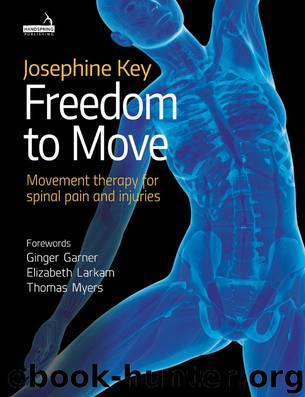Freedom to Move by Key Josephine

Author:Key, Josephine [Key, Josephine]
Language: eng
Format: epub
Publisher: Handspring Pub Ltd
Published: 2018-09-13T16:00:00+00:00
Potential problems in yoga
In standing poses, locking of the legs with poor pelvic control, and associated CPC activity because of poor axial FP control, means that Gloria cannot “hold the line” well and so she will also lock-in with the shoulder inferior tethers for stability (see Fig. 3.20 ). Unless checked, this pattern will also carry through into forward bends (Fig. 5.43a ) and positions such as Dog pose (Fig. 5.43b ). Gloria’s axial and shoulder inferior tethers are reinforced; her dome becomes more pronounced, and her thorax stiffens, while her lumbo-pelvis is further strained into end-range flexion (see Fig. 8.9 ).
This also helps explain her chronic nonspecific LBP and knee pains. Although she likes to walk, the shoulder inferior tethers limit arm swing and thoracic rotation while the pelvic ones limit pelvic rotation. All this, combined with poor axial FP support, results in mid-lumbar “wind” – further feeding into her chronic nonspecific LBP and knee pain (see Figs 4.22b and 4.26c ).
The dominance of inferior tethers can also be seen in simple poses such as Ex. 21 (Cat/Camel). Performed correctly, this exercise is a nice way of exploring the reciprocal relationship between the secondary and primary curves of the spine (See Ch. 2 , Gravity) while activating the FPs to help overcome the mal-effects of the inferior tethers:
• In Cat : Ideally pelvic FP1 and then shoulder FP1 lead the movement with control of the axial FP enabling the spine to lengthen into the secondary curves and the center to remain open (see Fig. 7.21a ). Note correct pelvic FP1 action here involves a backward weight shift, which makes activation of shoulder FP1 and head FP1 easier.
However, unsurprisingly, Gloria will employ a CPC strategy, throwing her lower ribs forward with little activation of the axial FP, initiation from pelvic FP1, and the shoulder FP1. The spine is compressed and does not lengthen – and the inferior tethers are reinforced in the CNS. The lack of backward weight shift makes it harder to find either shoulder and head FP1 ( Fig. 5.44a )
Download
This site does not store any files on its server. We only index and link to content provided by other sites. Please contact the content providers to delete copyright contents if any and email us, we'll remove relevant links or contents immediately.
Periodization Training for Sports by Tudor Bompa(8170)
Bodyweight Strength Training by Jay Cardiello(7841)
Born to Run: by Christopher McDougall(7065)
Inner Engineering: A Yogi's Guide to Joy by Sadhguru(6725)
Asking the Right Questions: A Guide to Critical Thinking by M. Neil Browne & Stuart M. Keeley(5635)
The Fat Loss Plan by Joe Wicks(4847)
Bodyweight Strength Training Anatomy by Bret Contreras(4612)
Yoga Anatomy by Kaminoff Leslie(4306)
Dynamic Alignment Through Imagery by Eric Franklin(4118)
Science and Development of Muscle Hypertrophy by Brad Schoenfeld(4089)
ACSM's Complete Guide to Fitness & Health by ACSM(3989)
Exercise Technique Manual for Resistance Training by National Strength & Conditioning Association(3956)
The Four-Pack Revolution by Chael Sonnen & Ryan Parsons(3932)
Bodyweight Strength Training: 12 Weeks to Build Muscle and Burn Fat by Jay Cardiello(3915)
The Ultimate Bodybuilding Cookbook by Kendall Lou Schmidt(3886)
Yoga Anatomy by Leslie Kaminoff & Amy Matthews(3863)
American Kingpin by Nick Bilton(3757)
Nutrition for Sport, Exercise, and Health by Spano Marie & Kruskall Laura & Thomas D. Travis(3715)
Yoga Therapy by Mark Stephens(3703)
